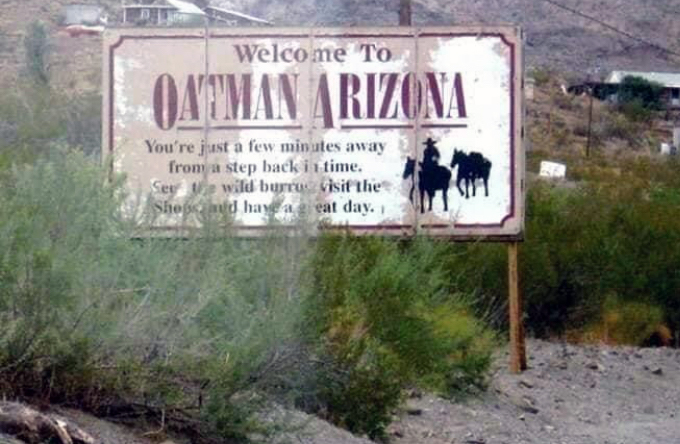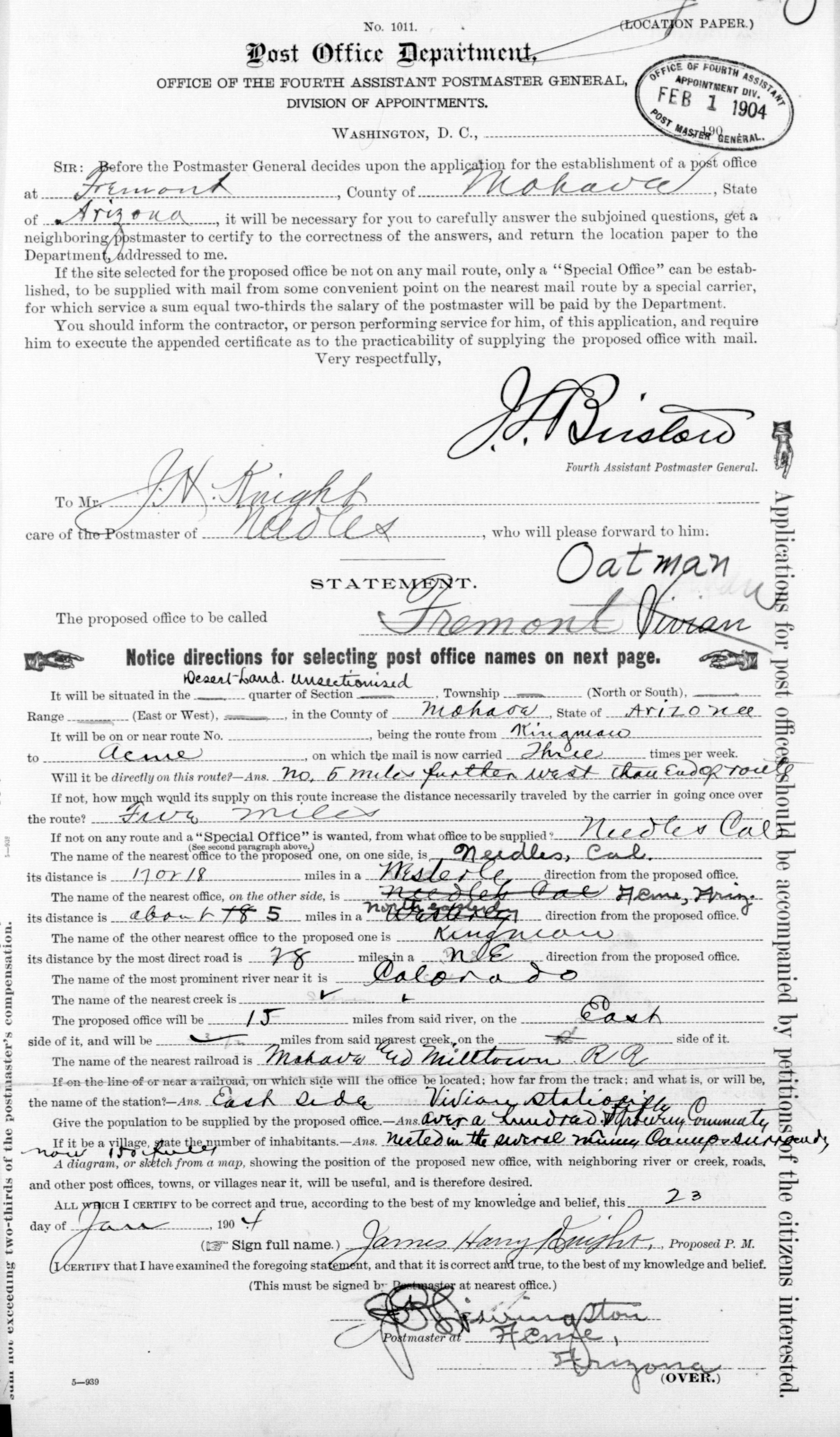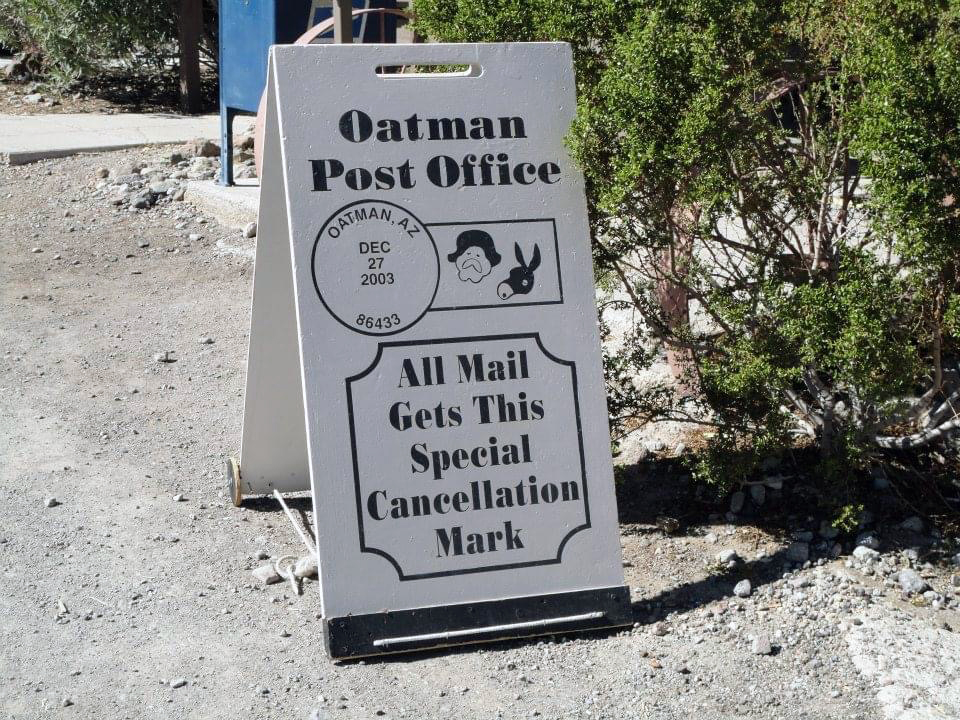Lupton – Houck – Sanders – Chambers – Petrified Forest / Painted Desert – Holbrook – Joseph City – Winslow – Meteor City – Meteor Crater – Winona – Flagstaff – Bellemont – Williams – Ash Fork – Seligman – Grand Canyon Caverns – Peach Springs – Truxton – Crozier – Valentine – Hackberry – Antares – Kingman – Golden Valley – Oatman – Golden Shores – Topock
Tap above to listen to an audio narration of this station’s content.
“Oatman was born a mining boom town. But it was the gold that has flowed from the pockets of travelers, first on the National Old Trails Road and then Route 66, that has kept the town alive and thriving, even long after the mines closed. And it was the money spent by travelers that gave Oatman the diversified economy needed to survive the ebb and flow that plagued mining towns, and that led many to become ghost towns.
By 1912, the year of Arizona statehood, a new breed of adventuresome tourist was flocking to the southwest. They were called automobilist.

To develop the Southwest link in a planned transcontinental highway and to capitalize on envisioned tourism, community leaders in Kingman and Oatman, Arizona, and Needles, Barstow, and Victorville, California launched an aggressive campaign to ensure that the proposed National Old Trails Road followed the Santa Fe-Grand Canyon-Needles National Highway.
On June 22, 1912, an article published in “The Needles Eye” noted that this road from Cajon Pass to the Colorado River was one of the best in the desert and that it was partially macadamized. Then in the issue of November 30, 1912, an article detailed another meeting of the Mohave County Good Road Boosters held in Needles. At this meeting plans were finalized to work with the Automobile Club of Southern California to promote natural wonders to be found on this route from Los Angeles via Barstow, Needles, Oatman, Kingman, Seligman, Ash Fork, Williams, Flagstaff, Winslow, Holbrook, Springerville, and St. Johns.
With designation of the National Old Trails Road, the Automobile Club of Southern California commenced work to ensure that it was adequately signed. Soon a trickle of adventuresome tourists became a torrent. In 1915, the year that Edsel Ford and his college buddies followed the National Old Trails Road to California, more than 15,000 people attended the Panama Pacific Exposition from outside that state and they arrived by automobile.
Popularity of the National Old Trails Road as the gateway to scenic wonders and as one of the best roads in the southwest was fueled by a diverse array of publicity. Emily Post penned By Motor to The Golden Gate, a best selling book about her adventures. The 1914 Desert Classic automobile race that followed the National Old Trails Road from Los Angeles to Ash Fork, and then south to Phoenix, with Louis Chevrolet and Barney Oldfield as the favored contenders placed an international spotlight on the road.

In November 1926, signs with a double six began replacing those designating the highway as the National Old Trails Road. And in early 1927, the embryonic U.S. Highway 66 Association began building on the popularity of the National Old Trails Road and launched an ambitious promotional campaign branding Route 66 as the Main Street of America.
The rest, as they say, is history. Route 66 is not our most historic or most scenic highway. But it and its predecessor the National Old Trails Road have benefitted from more than a century of promotion. The Transcontinental Foot Race dubbed the Bunion Derby gave Route 66 international media attention. In 1932 a marketing campaign billed Route 66 as the scenic route to the Olympics in Los Angeles. Then there was The Grapes of Wrath, the book and the movie, and a catchy tune about getting your kicks on Route 66 made a chart topper by crooner Nat King Cole. On their popular television program, Desi and Lucy followed Route 66 to California. And then there was an award-winning television show about two young men, their Corvette and adventures on a road signed as Route 66.
And so, Route 66, a highway that officially ceased to exist in 1985, has become the most famous highway in America. There are Route 66 associations in most European countries as well as in Canada, Japan, and Australia. Companies based in New Zealand, Germany, the Czech Republic, Australia, Italy, the UK, and other countries specialize in Route 66 tours. The European Route 66 Festivals held in 2016 and 2018 were attended by enthusiasts from throughout the world.
In the era of Route 66 renaissance, Oatman has been transformed into a magical destination for legions of enthusiasts. In this dusty old mining town the romanticism of the western frontier is intertwined with the infectious excitement of a Route 66 adventure, and the line between past, present, and even the future is blurred.” ~Jim Hinckley
The Post Office

The first Oatman post office opened in 1904 according to United States postal records, however, other records show Oatman starting in 1909. . Oatman was previously known as “Blue Ridge”. Newspaper records show that mail was brought into Oatman once a day at noon.

The Oatman Post office was previously located in the building that is now Judy’s Saloon. The floor in what is now Judy’s Saloon, is from the Old Ft. Mohave Indian School. The Mohave Miner paper reported in December 1940 that the new building was being built by Clyde Bollinger with the lumber being purchased from the Lee’s Lumber Company of Oatman. It was leased by the government for use as a post office.

Oatman’s Post office is now across the street. Hours of operation are limited but you can always drop a postcard in the mailbox out front. Our post office will hand cancel your stamp with a special stamp that was designed by Jackie Rowland over 30 years ago. Jackie Rowland was our town historian, an author, proprietor of Fast Fanny’s, a member of The Oatman Fire Department, Board member and lifetime member of the Oatman-Goldroad Chamber of Commerce and active in the Arizona of Route 66 Association.

“OATMAN SCAVENGER HUNT” – Take a photo of yourself in front of any of the spots mentioned in this tour (or what is currently standing there), and email them to tailingsoftime@gmail.com and we will post them on our sites. Thank you for visiting and learning about our town.”
***The “Historic Oatman Walking Tour” was created for the town of Oatman, by Rob Borden, founder of the Saddle Sore Ranch (aka “SSR”), and commissioned by the Oatman Gold Road Chamber. Content contributions were made by the Oatman Chamber of Commerce, Oatman Tailings Of Time Historical Society, Leanne Toohey, Oatman residents and other historic contributors. The Saddle Sore Ranch is located just 12 miles east of Oatman, at milepost 36.5 on Historic Route 66. For more information, visit us online at www.SaddleSoreRanch.com, or email us at LiveFromSSR@gmail.com ***
